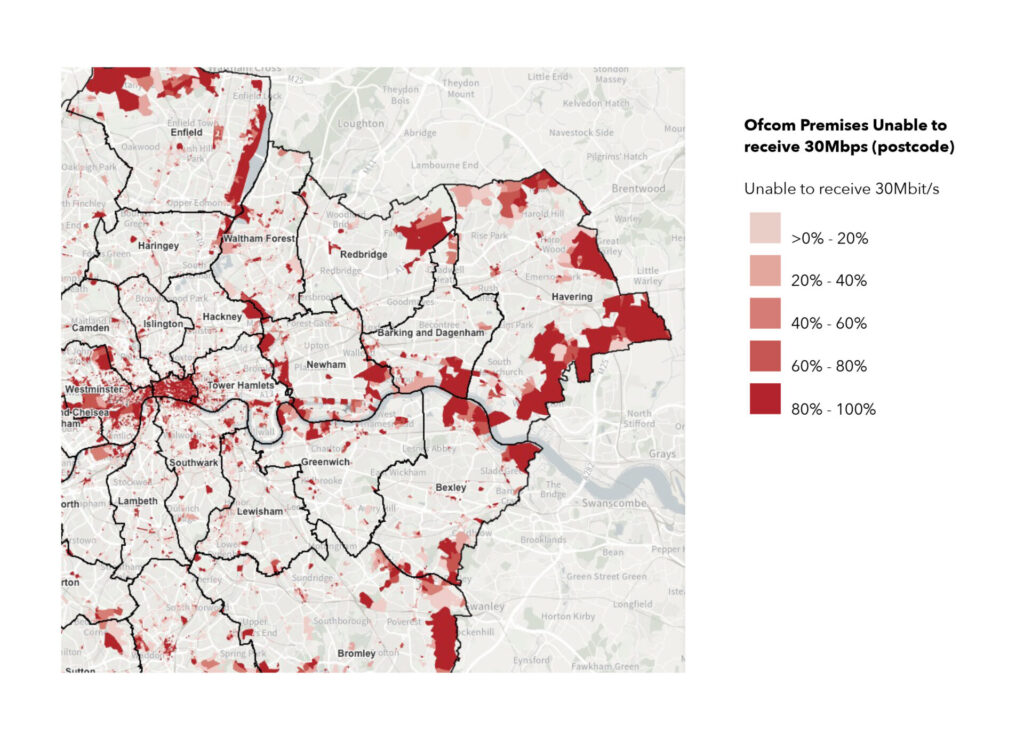Digital connectivity is fundamental to unlocking growth across our sub-region and beyond.
We were delighted to share insights into digital investment needs across our boroughs in the Thames Estuary Growth Board’s recently launched ‘Fair Economic Growth through Digital Connectivity’ paper.
The paper sets out the Growth Board’s plan to establish the Thames Estuary region as the UK’s next AI and digital powerhouse. We back the Board’s call to action for targeted support and bold public-private sector collaboration across east London, north Kent and south Essex to drive forward the UK’s digital future.
Digital connectivity in our London sub-region
While we have secured around £20m investment into our boroughs to improve digital connectivity, our research highlights barriers preventing us from achieving ubiquitous world-class connectivity befitting of expectation of being part of London.
As a result, we need additional funding to:
- Expand dark fibre spines – notably to growth areas but also key areas of regeneration.
- Enhance service provision to public sector sites and assets.
- Anchor inward investment.
- Deliver local business and residential support to drive adoption (awareness, stimulation and possible connection subsidy.)
- Facilitate enhanced mobile coverage and capacity (eg neutral hosts, use of assets.)

⇒Read our Delivering Economic Growth in Local London: Digital Connectivity Requirements paper.
Cllr Anthony Okereke, Chair of Local London and Leader of the Royal Borough of Greenwich, said “As the fastest growing part of the capital with a population greater than the cities of Birmingham, Manchester and Liverpool combined, we welcome the Thames Estuary Growth Board’s position paper. We are committed to creating inclusive growth for people and businesses in our sub-region; investment in digital infrastructure to tackle over 100,000 premises without gigabit capable broadband connectivity is fundamental to achieving this and supporting local, regional and national economic growth.”
Mayor Rokhsana Fiaz OBE, Local London representative of the Thames Estuary Growth Board and Mayor of Newham London, said “We know that digital inclusion is vital for our people as the impact of technology and the digital age is changing how we live and accessibility will inform life chances. The government has placed a priority on addressing digital access because the digital exclusion numbers are stark, with 1.6 million people in the UK currently not online. Across the Local London area it is even more pronounced, with 100,000 premises not connected or amongst the lowest level of digital capability meaning that the opportunities of life are curtailed.
That’s why we have an ambition through our involvement in the Thames Estuary digital corridor, which will bring high-speed connectivity to east London as this report sets out. It will enable digital inclusion for our people so that they can seize the opportunities of economic growth, over sustaining digital ‘not spots’ which is holding our people back. That’s why fair economic growth through digital connectivity in our boroughs and across the Thames Estuary region is a must.”
Below: map showing slow and no connectivity areas in Local London boroughs and beyond.
The Thames Estuary region, one of two nationally important growth corridors intersecting the Local London sub-region, has the potential to add £190bn to the UK economy by 2050[1].
The Local London economy represents around £55bn[2], with potential to increase with the right investment. Our boroughs are working together through Local London to unlock sustainable inclusive growth across north east and south east London.
- Read the Thames Estuary Growth Board’s ‘Fair Economic Growth through Digital Connectivity’ paper.
- Read our Delivering Economic Growth in Local London: Digital Connectivity Requirements paper.
- Discover more about our strategy for tacking digital infrastructure deficits in Local London.
[2] ONS snapshot data from 2022 (not adjusting for inflation)
We are delighted to share that Mayor Rokhsana Fiaz OBE has joined the Thames Estuary Growth Board as its newest Board member.
Representing Local London, Mayor Fiaz will ensure the interests of boroughs in the north east and south east of the capital are integral to the Thames Estuary Growth Board’s fair, sustainable ambitions for economic growth.
Mayor Fiaz OBE, Mayor of Newham was appointed by her peers to represent the nine boroughs comprising Local London, a dynamic sub-region representing around 2.6 million residents and 100,000 businesses, to consolidate relationships with the Thames Estuary, the UK’s biggest growth opportunity.
The Mayor will be joining a highly accomplished board which includes Jules Pipe, Deputy Mayor of London for Planning and Regeneration, Councillor Teresa O’Neill OBE, Leader of Bexley Council and Councillor Anthony Okereke, Leader of the Royal Borough of Greenwich and Chair of Local London.
The board also boasts a diverse range of private sector leaders, including Devrim Celal, CEO of KrakenFlex, Gavin Chapman, Managing Director at Barclays, and Vera Kukic, Partner in IBM’s Strategy Consulting Business. Their collective expertise ensures a robust and dynamic approach to driving growth and innovation across the Thames Estuary region.
In addition to sharing geography, the Thames Estuary Growth Board and the Local London partnership are both committed to driving inclusive economic growth and regeneration, ensuring communities benefit from investment and opportunity.
Cllr Anthony Okereke, Chair of Local London and Leader of the Royal Borough of Greenwich, said: “Our Local London boroughs are distinct from other parts of the capital. We have challenges, but also huge opportunities that are shared across the Thames Estuary region. We are all committed to driving sustainable and inclusive growth that benefits all of our communities, and I am delighted that Mayor Fiaz will represent our boroughs and continue our close connection with the Thames Estuary Growth Board.”
Kate Willard OBE, Thames Estuary Envoy and Chair of the Growth Board, said: “Mayor Fiaz’s commitment to fair growth and social impact aligns perfectly with our vision for the Thames Estuary. She is a proven leader who understands how to turn bold ideas into tangible benefits for local communities. We are thrilled to have her on board as we continue driving investment, infrastructure, and opportunity across the region.”
Mayor Rokhsana Fiaz OBE, Mayor of Newham and representative of Local London, said: “The Thames Estuary, including the dynamic boroughs to the east of London, is central to the future prosperity of the whole country as we support the government’s national growth mission to drive better living standards through investment to build more homes and create jobs. I’m excited to be joining the Growth Board at such a crucial time and look forward to getting stuck in as we unlock the wealth of opportunities for communities across the Thames Estuary and accelerate sustainable development and fair growth.”
Mayor Fiaz’s appointment further strengthens the Growth Board’s partnership with London’s local authorities, ensuring that the voice of communities remains at the heart of its work to attract investment, drive innovation, and support fair growth.
Discover our Three Year Plan: Towards 2026
Notes to Editors:
About the Thames Estuary Growth Board
The Thames Estuary Growth Board is dedicated to unlocking the economic potential of the Thames Estuary. By fostering collaboration, driving investment, and spearheading innovative development projects, the Board is committed to transforming the Estuary into a thriving, sustainable, and economically vibrant region.
The Growth Board works to engage national and international investors, showcasing the Estuary’s potential as a prime location for investment. Through targeted initiatives, the board will highlight key development sites, foster investor relations, and drive forward the region’s economic prospects.
The Growth Board remains steadfast in its commitment to driving growth that is not only economically beneficial but also equitable and environmentally sustainable. Through these strategic initiatives and the dedicated support of our stakeholders, we are setting the stage for a brighter, more prosperous future for the Thames Estuary.
Find out more: www.thamesestuary.org.uk
Media Contact: Hannah Staunton, Director of Communications at the Thames Estuary Growth Board. Email: press@thamesestuary.org.uk
About Local London
Local London is a sub-regional partnership of nine boroughs: Barking and Dagenham, Bexley, Bromley, Enfield, Greenwich, Havering, Newham, Redbridge and Waltham Forest.
Representing around 2.6 million residents and 100,000 businesses, we are a champion for this sub-region to ensure it responds to a set of mutual issues and challenges, and benefits from existing and emerging opportunities.
Find out more: www.local.london
Local London Media contact: helen.mckay@redbridge.gov.uk / 07796 837 411
About Mayor Fiaz
Rokhsana Fiaz OBE has served as Executive Mayor of Newham since May 2018, delivering her Building a Fairer Newham plan.
She is portfolio lead for Inclusive Economy, Strategic Housing Delivery and Culture, including community wealth building, place and economic regeneration, planning and development; and leads on the ambitious affordable social housing programme.
She is London Council’s Data and Innovation lead, co-chair of the Royal Docks Enterprise Zone and chair of the Local London Growth and Recovery Board. Previously she was CEO of an international UNESCO supported charity and has led large-scale capital projects for councils, European Commission and Council of Europe. In 2009 she was awarded the Order of the British Empire for services to Black and Minority Communities.
On Thursday 19 January, the Government announced the successful bids in the second round of Levelling Up funding.
Three projects from the Local London sub-region were among over 100 successful bids from England, Northern Ireland, Scotland and Wales awarded a share of £2.1 billion from Round 2 of government’s flagship Levelling Up Fund.
Two boroughs from Local London were among the eight successful bids in the capital.
Cllr Baroness O’Neill of Bexley OBE, Chairman of Local London, welcomed the awards saying “I am delighted for the successful bids that will bring funding to Local London, transforming two of the sub-region’s town centres and making improvements to Leyton station which will enhance connectivity into this part of London for more people. Our sub-region is vibrant and growing fast; this funding will help unlock opportunities for people in our boroughs.”
Double award for Waltham Forest
London Borough of Waltham Forest is set to receive the highest amount of any London borough in this round of funding. The East London borough was awarded approximately £31m in total from the Levelling Up Fund to improve Leyton Station and Walthamstow town centre.
Through a joint bid led by Transport for London (TfL) and the Greater London Authority (GLA) approximately £14m has been granted to make improvements to Leyton Station including step-free access to each platform as well as a new ticket hall, concourse, and gate line.
The Council’s second bid was awarded £17.2m to transform to public spaces around the planned cultural quarter in Walthamstow to make the area more appealing for residents and visitors.
Find out more about the awards made to Waltham Forest.
Bid success for Barking and Dagenham
Local London’s other successful bid was made to London Borough of Barking and Dagenham to make improvements to Dagenham Heathway. The bid submitted by Be First, the council’s regeneration company, was awarded £10.88m to make the borough’s second largest town centre fit for the 21st Century.
Find out more about Barking and Dagenham’s successful bid.
Successful bids in our neighbouring growth regions
Further successful bids in the two growth corridors that intersect the Local London sub-region will support a number of cultural and transport projects.
More than £82m awarded to the Innovation Corridor
The UK Innovation Corridor is set to receive over £82m for cultural projects in Harlow and Waltham Cross, and improvements for Peterborough station, including:
- Over £14m to Borough of Broxbourne Council for new skatepark, outdoor gym, sports pavilion and running track in Waltham Cross to boost the health and wellbeing of local people.
- Over £47m to Cambridgeshire and Peterborough Combined Authority to build a new entrance and footbridge for Peterborough train station.
- Almost £20m to Harlow District Council to create a new music and arts venue, including music school and space for the creative industries.
Over £103m for the Thames Estuary
The Thames Estuary will receive over £103m for projects in Canterbury, Dover and Sheerness, including:
- £19.9m to Canterbury City Council to reopen Canterbury Castle, improve historic sites, build better green spaces and create new walking and cycling routes.
- £18.1m to Dover District Council to build a new campus on brownfield land that will offer training opportunities in creative and digital industries creating new job opportunities in the region.
- £45m to Kent County Council to improve the flow of traffic from the UK to the EU, with more border control points and a new exit route to reduce congestion on local roads.
- £20m to Swale Borough Council to transform Sheerness’s Beachfields seafront and to expand the further education college and make space for new offices and studios for local small businesses.
To date £3.8billion has been allocated from the UK government’s flagship £4.8 billion Levelling Up Fund.
The government has confirmed there will be a further round of the Levelling Up Fund, details have yet to be announced.
Discover more about Levelling Up funding.
The City of London Corporation has approved plans for a major regeneration programme, which will see London’s historic wholesale markets relocated to a purpose-built site in Dagenham Dock East London, bringing thousands of jobs to the area.
On 17 November 2022, the Court of Common Council – the City Corporation’s principle decision-making body – voted to deposit a Private Bill in Parliament to relocate Billingsgate and Smithfield wholesale markets.
The City Corporation will invest nearly one billion pounds directly into Barking and Dagenham to regenerate 42 acres of industrial land into a modern, sustainable wholesale food market, stimulating the local economy and ensuring resilience in the food supply of London and the southeast.
The new market will bring an estimated 2,700 new jobs to Barking and Dagenham and support 7,850 jobs across the UK – an increase of 1,140 (or 17%) on the jobs supported by Billingsgate and Smithfield currently.
The relocation will stimulate economic growth, generating around £14.5 billion in cumulative productivity benefits (Gross Value Added) for the UK economy to 2049.
Relocating Smithfield Market offers the opportunity to reinvigorate an historic part of the Square Mile, preserving and opening up the listed buildings for the public to enjoy. The site will become home to the new London Museum, alongside a complementary cultural and commercial offer.
The land at Canary Wharf that will be unlocked by relocating Billingsgate could provide around 2,000 new homes and other social infrastructure.
Vice Chair of Local London and Leader of the London Borough of Barking and Dagenham, Cllr Darren Rodwell, said:
“I’m delighted we’ve reached this next milestone for the relocation of the world-famous wholesale markets to the borough.
“London is moving east, delivering huge opportunities, like this, for new jobs and hundreds of millions of pounds of investment into the local economy.
“I’m excited by plans we are working on with stakeholders for a new Good Food Economy Partnership to unlock the full opportunities from the food sector for local residents and businesses.
“This includes a pipeline for local talent with tailored training opportunities, apprenticeships and new business start-up opportunities alongside an improved and healthy food offer.”
The City Corporation owns and manages three wholesale food markets – Billingsgate Market in the London Borough of Tower Hamlets, New Spitalfields Market in the London Borough of Waltham Forest and Smithfield Market in the City of London.
The City Corporation’s ambition remains to relocate New Spitalfields to Dagenham Dock alongside Billingsgate and Smithfield at a later date.
London’s wholesale markets, and many others across the country, are governed by legislation which means they can only be relocated with consent from Parliament. The deposit of a Private Bill by the City Corporation on 28 November will commence this process.
The new market at Dagenham Dock is expected to open between 2027-2028.
Chairman of the City Corporation’s Policy and Resources Committee, Chris Hayward, said:
“This is a major milestone in an ambitious programme with economic growth at its heart – something our country so clearly needs.
“Our investment in delivering modern, environmentally-sustainable wholesale markets in Barking and Dagenham will boost the economy across east London, supporting jobs, skills and training.
“The existing Smithfield Market site is at the heart of our vision for Destination City, where the new London Museum will showcase the capital’s rich culture and history to millions of visitors.
“Relocating our markets will help ease traffic and improve air quality in inner London, while unlocking land at Billingsgate for new housing.”
The City Corporation is the major funder of the new Museum of London, soon to be rebranded the London Museum, which will be one of Europe’s largest cultural projects.
More information about the City Corporation’s Markets Co-location Programme can be found here.

